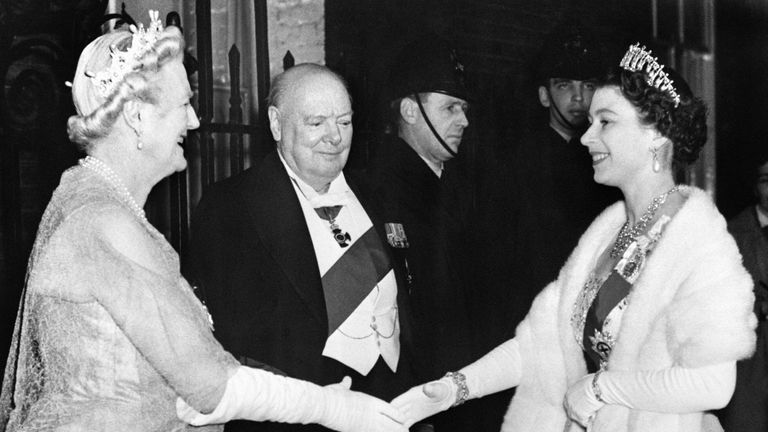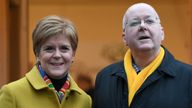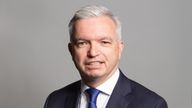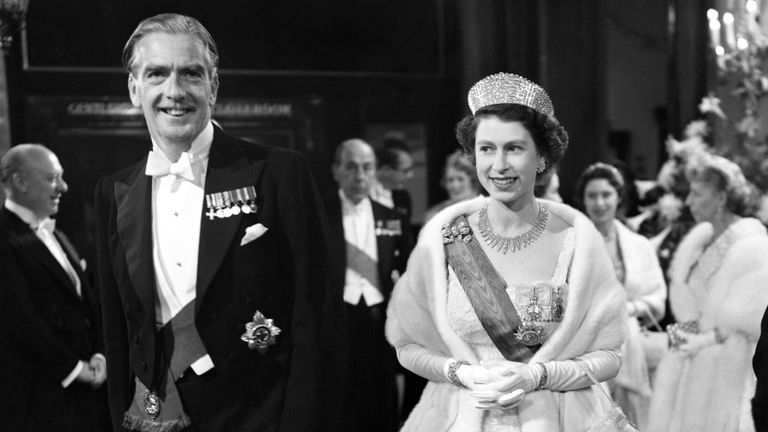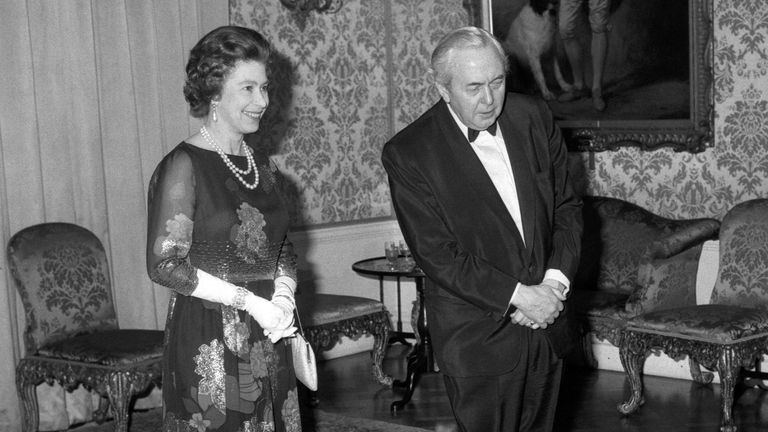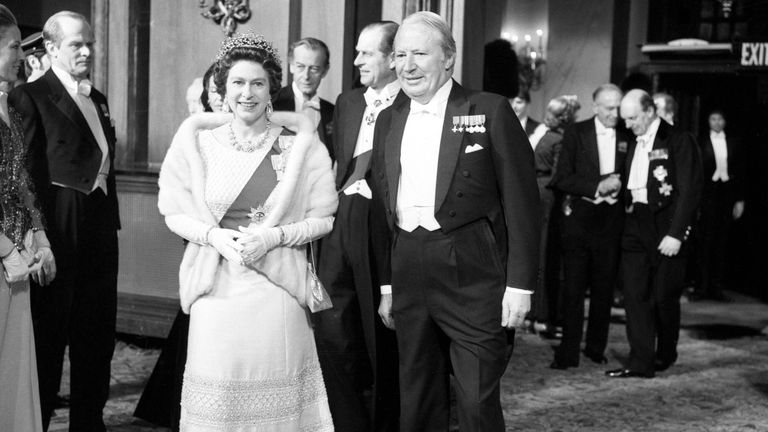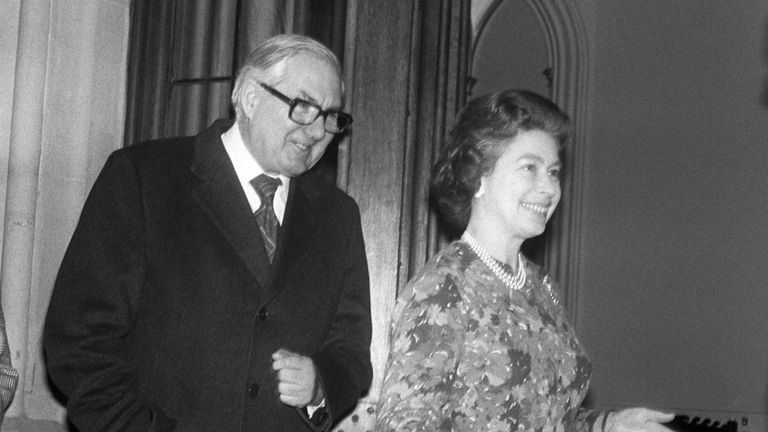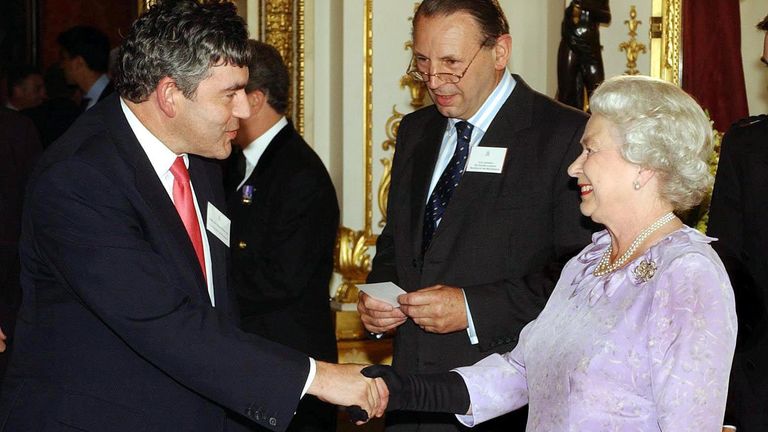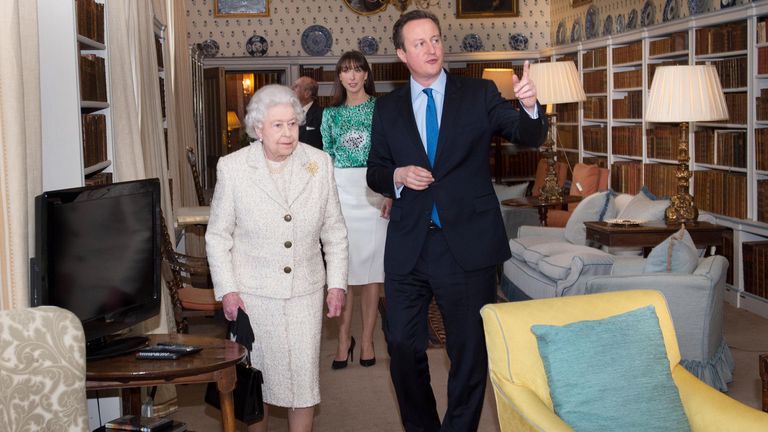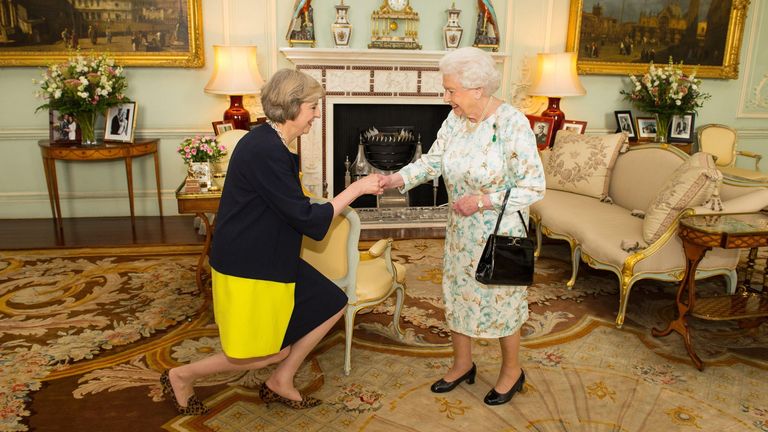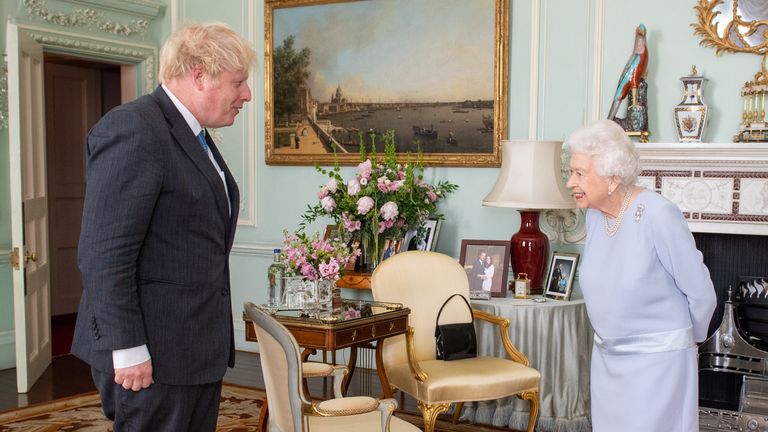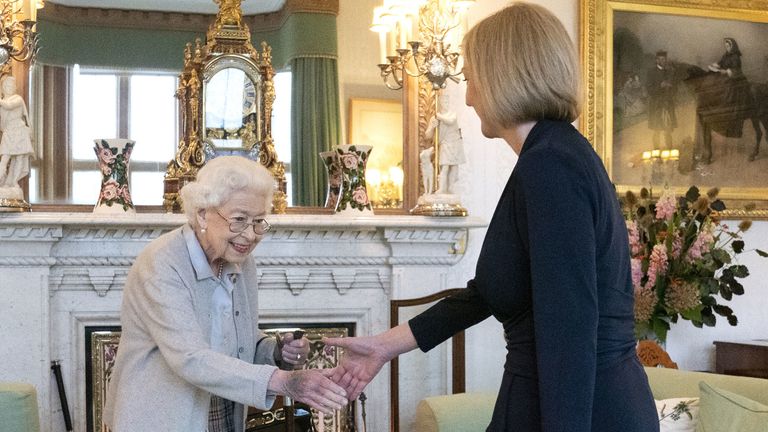The Queen and her 15 prime ministers - From Winston Churchill to Liz Truss
The Queen had to 'prove herself' with Churchill and had difficult relations with Thatcher.
Friday 9 September 2022 09:22, UK
Throughout her reign, the Queen worked with 15 prime ministers.
Many of them were born after her coronation, some were uneasy about royal protocol - and others struggled with weekends at Balmoral.
But with her long and vast experience of home and foreign affairs, nearly all of them valued the advice the Queen gave them during their weekly audiences at Buckingham Palace.
Winston Churchill - 1951-55
Despite being credited with winning the Second World War, Winston Churchill lost the 1945 election, before returning to Downing Street for a second term in 1951.
When Elizabeth became Queen in 1952, Churchill, 77, was sceptical the 25-year-old was up to the job.
"Winston Churchill initially was very unsure about her," historian Kate Williams said.
"He said she was too young, she was just a child, and he wasn't the only person who thought that. She had to prove herself."
But as time went on, he warmed to her and they began to enjoy their weekly meetings, which would sometimes go on for two hours.
After her coronation in 1953, Churchill suffered a stroke, but he kept it from his colleagues.
The Queen urged him to tell the truth and invited him and his wife to Balmoral, a trip he greatly enjoyed and credited with aiding his recovery.
With a shared love of horses and racing, the pair are believed to have laughed a lot, with Churchill eventually having "near idolatry" for the Queen, according to the late politician Roy Jenkins.
When he resigned in 1955, reports say she wrote him a handwritten letter telling him how much she would miss him.
No other would "ever for me be able to hold the place of my first prime minister, to whom both my husband and I owe so much and for whose wise guidance during the early years of my reign I shall always be so profoundly grateful," she wrote.
When he died in 1965, the Queen broke royal protocol and arrived at his funeral before his family.
Sir Anthony Eden 1955-57
Sir Anthony Eden's time with the Queen was short. Some argue his premiership was doomed from the beginning by a botched medical operation two years before he took office.
With the gigantic shoes of Churchill to fill, it was always unlikely Eden's relationship with the Queen would compare.
According to his wife Clarissa, when he went to Buckingham Palace to form a government, the pair talked about a number of things before the topic actually came up.
According to Mrs Eden, he eventually said: "Well Ma'am," to which she replied: "I suppose I ought to be asking you to form a government."
Historians say the pair got along well and that the Conservative prime minister was comforted by the Queen's listening ear.
Many of their audiences were spent discussing Princess Margaret's potential engagement to divorced Group Captain Peter Townsend, which eventually crumbled under the disapproval of the family.
It was the Suez crisis of 1956 that caused Eden's downfall.
Although politically impartial, the Queen's former private secretary Lord Charteris has suggested the Queen was disapproving of the prime minister's handling of the crisis.
"I think the Queen believed Eden was mad," he said.
Harold Macmillan - 1957-63
When Harold Macmillan took office in 1957, the Conservative Party was still intensely divided over the fallout from Suez.
During their first meeting, he told the Queen he doubted his government would last six weeks.
When he resigned, she reminded him it had lasted six years.
In his diaries, Macmillan praised Her Majesty's knowledge of foreign affairs, noting: "She showed, as her father used to, an uncanny knowledge of details and personalities. She must read the telegrams very carefully."
But it was the end of his premiership that made history.
When the Queen visited Macmillan in hospital, he told her that the party wanted Lord Home to replace him and is believed to have convinced her to exercise her royal prerogative in sending for him.
This constitutional breach ended in controversy as it transpired Lord Home was not the cabinet's first choice.
Sir Alec Douglas-Home - 1963-64
Lord Home was the first prime minister the Queen already knew when they took office.
Born into a family of Scottish aristocrats, he was a childhood friend of the Queen Mother's, having grown up as her neighbour.
Lord Home and the Queen shared many interests: they both loved dogs, and he is credited with naming some of her horses.
Former private secretary Lord Charteris said the Queen "loved Alec" as they were "the same sort of people".
However, they had fewer than 52 audiences together, as Lord Home's term lasted two days shy of a year - the shortest in the 20th century.
Harold Wilson - 1964-70 and 1974-76
Wilson was the first Labour prime minister the Queen encountered, offering her a new insight into life outside Britain's upper echelons.
The prime minister was keen to prove himself capable of following protocol. He wrote in his autobiography: "Contrary to all I had understood about the procedures, there was no formal kissing of hands."
Wilson went on to become one of the Queen's favourite prime ministers, and the pair thoroughly enjoyed their weekly meetings.
Then-Labour cabinet minister Barbara Castle said: "Harold was very fond of her and she reciprocated it."
Ms Castle also noted that Wilson kept her "well-informed" of how things were outside her social class and encouraged her to drop some of the more archaic traditions from the reign of Queen Victoria.
Some have speculated that the timing of his resignation at the end of his second term was deliberately made to coincide with the breakdown of Princess Margaret's marriage, in order to distract the media from it.
Edward Heath - 1970-74
Edward Heath brought the Conservatives back to power between Wilson's two terms.
In vast contrast to his predecessor, Heath is thought to have been one of the Queen's least favourite leaders.
They are reported to have had a difficult relationship, with Heath uncomfortable around women and lacking in charm.
His views on the Commonwealth were thought to be different from the Queen's, which she may have taken personally.
However, amid the Troubles in Northern Ireland, the pair did bond over their shared horror at the scale of violence and loss of life.
Sir John Major said that, several years later, when he was PM, he invited them both for a private dinner and Heath, then very elderly, fell asleep.
Despite their differences, Heath complimented the Queen's general knowledge, once describing her as "undoubtedly one of the best-informed people in the world".
James Callaghan - 1976-79
Callaghan's time in office marked the last time Labour would be in power for two decades.
Underlining the formal nature of their relationship, he said he got "friendliness but not friendship" from the Queen.
However, Callaghan, an ex-member of the Navy and son of a seaman, also said Her Majesty respected people for serving in the armed forces - and for that reason she warmed to him.
The Queen was believed to enjoy his company, although Callaghan was careful not to tell even her private secretary what they discussed each week.
Eventually, their relationship became so relaxed that she broke with protocol during a walk around Buckingham Palace and placed a flower in his buttonhole.
Margaret Thatcher - 1979-90
While many expected the Queen to get on with Britain's first ever female prime minister, the relationship between the two women was strained.
Although politically impartial, in private the Queen is thought to have been worried by the social implications of Thatcherism and the changes she made.
This led to an overly formal, awkward, and at times frosty relationship.
Thatcher's biographer Charles Moore said that from the prime minister's side the tension was fuelled by "constitutional correctness, old-fashion deference and a certain unease".
And instead of getting her views, Thatcher often ended up lecturing the Queen, which she "found irritating", according to one former general.
While most PMs relished the chance to visit the Queen at Balmoral, Thatcher saw the mini-breaks as a distraction from her work.
When she was forced to resign in 1990, she was the Queen's longest-serving PM.
John Major - 1990-97
During John Major's premiership, both he and the Queen endured turbulent times.
While Major had the Gulf War and economic disaster to deal with, the Queen had to navigate the breakdown of Charles and Diana's marriage and the sensational media coverage that came with it.
The Queen called 1992 - which saw the breakdown of the marriages of three of her children and a devastating fire at Windsor Castle - her "annus horribilis".
As a result, they valued each other's advice, and their weekly meetings became a source of mutual support.
Major described her as "compassionate, shrewd, well-informed, pragmatic and wise".
He said she asked "well-directed questions… that any prime minister would be foolish not to consider with care".
Amid tensions over Diana, he added: "The Queen, far from being cut off from her people, is very much aware of the shifting tides of public opinion - indeed often ahead of it."
Tony Blair - 1997-2007
Tony Blair's New Labour brought a new type of politics, which did not always fit in with the Queen.
During the pair's first meeting, the Queen was quick to point out that Blair was just one month old when she was crowned in 1953.
According to Blair, she said to him: 'You are my 10th prime minister. The first was Winston. That was before you were born."
Blair described her as "direct", adding: "I got a sense of my relative seniority, or lack of it."
She also refused to call him "Tony", despite his requests.
He disliked a lot of royal protocol, describing a visit to Balmoral as "a vivid combination of the intriguing, the surreal, and the utterly freaky.
"The whole culture of it was totally alien, of course, not that the royals weren't very welcoming."
When Princess Diana died in 1997, neither the royals nor her family wanted a large-scale funeral, but Blair insisted there was public demand for it.
On the Queen Mother's death in 2002, the palace is thought to have stopped the PM getting involved in the way he did previously.
Gordon Brown - 2007-10
When Blair resigned, his Chancellor Gordon Brown took over from him.
They couldn't have been more different in character, something that benefited Brown when it came to his meetings with the Queen.
Her Majesty was thought to be very fond of him, even attempting to mimic his Scottish accent occasionally.
She watched on television as he left Downing Street in 2010 and allowed Brown's wife and children to attend his final audience with her - something that had never happened before.
David Cameron - 2010-16
David Cameron already knew the Queen when he took office.
He went to the same elite public school - Heatherdown - as her son, Prince Edward, where the pair featured in a production of Toad of Toad Hall together.
They were even distantly related - fifths cousins, twice-removed - through their links to King William IV.
Despite their shared background, their relationship was not always easy.
When polls suggested in 2014 that Scotland could vote for independence in the upcoming referendum, Cameron was being hosted at Balmoral.
He later admitted he had sought the Queen's intervention to stop Scotland leaving the Union, asking her to simply "raise an eyebrow" - something he said wouldn't breach her political impartiality.
Ahead of the vote, the Queen urged people to "think very carefully about the future".
But afterwards, when Scotland voted to stay, Cameron risked damaging his relationship with the Queen when he was overheard telling former New York Mayor Michael Bloomberg she "purred" at the result.
He was forced to apologise, saying he was "very embarrassed" and "extremely sorry" for his choice of words.
Theresa May - 2016-19
Theresa May, Britain's second female prime minister, enjoyed a much more pleasant relationship with the Queen than Margaret Thatcher.
Both devout Christians, they bonded over the church and often discussed their love of the countryside.
With no children of her own, May was also often keen to hear about the Queen's grandchildren.
Her turbulent three years in office were dominated by Brexit, but Elizabeth is believed to have been "sympathetic" over the problems with Europe she inherited from David Cameron.
The Queen was thought to be sad to see her resignation speech, which saw the PM brought to tears outside Downing Street.
Boris Johnson - 2019-22
Boris Johnson's relationship with the Queen got off to a bad start.
He was accused of breaking protocol by asking her to suspend parliament just before the UK's scheduled departure from the EU in October 2019 in a bid to rush the Withdrawal Agreement through parliament.
But after he won the 2019 election, the pair began a proper, professional relationship.
When he announced the birth of his son Wilfred with then-fiancée Carrie Symonds, the Queen sent her congratulations.
And as he was recovering from his time in hospital with coronavirus, she allowed him to use the Buckingham Palace grounds for exercise.
When Prince Harry and his wife Meghan told Oprah Winfrey that an unnamed member of the Royal Family had made racist remarks about their son Archie, Johnson responded by saying he had the "highest admiration" for the Queen.
When Prince Philip died, the PM offered his condolences, saying: "We remember the duke... above all for his steadfast support for Her Majesty the Queen."
Liz Truss - 2022-present
Due to the mobility problems the Queen suffered in her final years, Liz Truss was the only prime minister she appointed at Balmoral - and not Buckingham Palace.
Previously when she was a Liberal Democrat, Ms Truss said she wanted to abolish the monarchy, claiming: "We do not believe people are born to rule."
But after becoming a Conservative, the PM said the Royal Family are "essential" to the UK.

